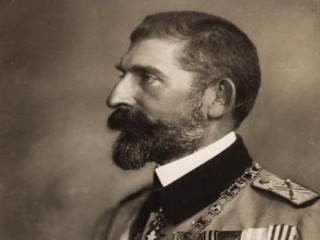
Ferdinand I (En.) biography
Date of birth : 1865-08-24
Date of death : 1927-07-20
Birthplace : Sigmaringen, Prussia
Nationality :
Category : Historian personalities
Last modified : 2011-04-29
Credited as : King of Romania, Princess Marie, Magda Lupescu mistress
Ferdinand I was king of Romania from 1914 to 1927. He presided over the expansion of Romania and the implementation of important reforms.
The second son of Prince Leopold von Hohenzollern-Sigmaringen and Princess Antonia of Portugal, Ferdinand von Hohenzollern-Sigmaringen was born on Aug. 24, 1865, at Sigmaringen, Prussia. Adopted as heir to the Romanian throne by his childless uncle, Carol I, in March 1889, Ferdinand married Princess Marie, the strong-willed granddaughter of both Queen Victoria and Czar Alexander II, on Jan. 15, 1893. The marriage produced six children, of whom the eldest, Prince Carol (1893-1953), assumed the throne in 1930.
As crown prince, Ferdinand reorganized Romania's armed forces, which he commanded in the Second Balkan War against Bulgaria in 1913. Upon the death of King Carol I, Ferdinand became king of Romania on Oct. 14, 1914. Although a Hohenzollern, Ferdinand declared war on Germany and Austria-Hungary in August 1916 to gain the Hapsburg Romanian-inhabited territories and to join all Romanians to their national state. The Austro-German forces, under Gen. August von Mackensen, occupied Bucharest in December 1916, forcing the royal family to flee to lasi, in Moldavia. The Romanian forces were defeated, an armistice was signed on Dec. 6, 1917, and the Peace of Bucharest was concluded on May 7, 1918. After the Allied victory of 1918, however, the dream of "Greater Romania" was realized by Romania's acquisition of Bessarabia, Bucovina, a portion of the Banat of Temesvar, and Transylvania. Ferdinand was crowned king of Greater Romania at Alba lulia on Oct. 15, 1922.
The most important reform measure enacted during Ferdinand's reign was the land reform promised his peasant soldiers during the war to reward them for their sacrifices and to prevent a peasant revolt such as had occurred under Carol I in 1907. Ferdinand himself set a notable example by being the first great landholder to give over his estates for distribution among the peasants.
The land reform measure and the decree of universal suffrage strengthened the National peasant party, strong in Romania's Transylvanian areas, but because of the party's demands for further radical land redistribution, the King refused its members entry into the government. Ferdinand also busied himself with extending full civil and military rights to all Romanian-born Jews and with reorganizing the army.
During Ferdinand's reign, Romania adhered to the Little Entente (including Czechoslovakia and Yugoslavia), concluded to oppose Hungarian revisionism; backed by France, entered a treaty with Poland to defend against Soviet attack; and followed a pro-French foreign policy. Ferdinand died in the royal palace near Bucharest on July 20, 1927. Because his heir, Carol, had renounced the succession in 1925 to live abroad with his mistress, Magda Lupescu, Ferdinand was succeeded by his young grandson, Michael, under a regency lasting until Carol's return to Romania in 1930.
















